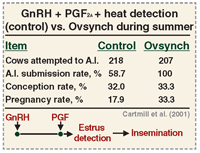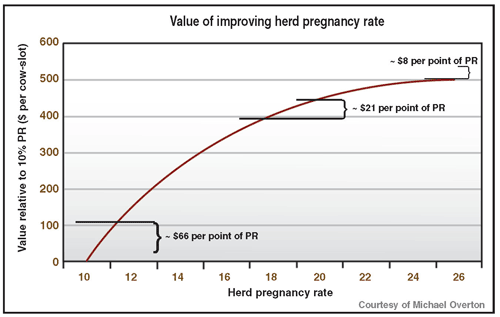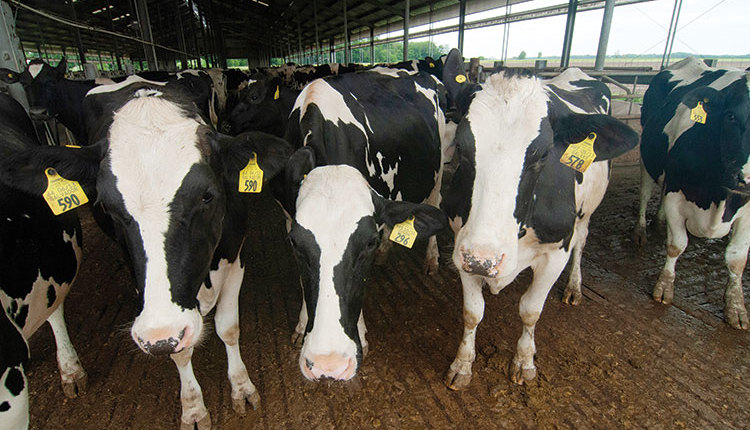The author is professor of animal sciences at Kansas State University, Manhattan.
Last month, we looked at the value of getting more cows pregnant earlier in lactation and reducing overall days open. Reducing days in milk for all cows in the herd results in greater profits. Let's look at how a 21-day pregnancy rate can contribute to greater profit.
When pregnancy rate increases, cows spend more of their herd life in early lactation. Mike Overton, D.V.M., has estimated the value of having more fresh cows in the herd. For example, in a 100-cow herd producing about 23,300 pounds of milk per cow annually, cows are producing about 80 pounds of milk per cow at a herd average of 200 days in milk. If pregnancy rate increases to reduce days in milk to 180 days, average milk per cow would rise by 3 pounds. Based on milk valued at an optimistic $18 per hundred pounds, payback to the dairy would increase by more than $15,000.
The best measure . . .
The 21-day pregnancy rate is a measure of how many cows become pregnant every 21 days. Every open cow is eligible to be A.I. bred during each estrous cycle. To achieve a pregnancy, the cow must be inseminated after detected estrus or receive a fixed-time A.I. So, heat detection rate or A.I submission rate measures the proportion of cows identified in heat and inseminated each 21-day cycle period.
The other part of the equation is whether or not the cow conceives. So, conception rate "times" submission rate equals the pregnancy rate. Each eligible open cow in the herd receives either a zero (not pregnant this cycle) or a one (became pregnant this cycle). Adding up all the cows receiving a one for each 21-day cycle (became pregnant) as a proportion of all open cows eligible to be inseminated produces the 21-day pregnancy rate.
Improving pregnancy rate . . .
Pregnancy rate increases when more cows are inseminated and (or) actual conception rates go up. An example of boosting pregnancy rate during summer by increasing A.I. submission rate is shown in the table. Estrus or ovulation in cows on two dairy farms was synchronized by injecting GnRH seven days before prostaglandin on consecutive Mondays. The control cows then were inseminated as detected in estrus after prostaglandin, whereas treatment cows received a second GnRH injection 48 hours after prostaglandin and were time inseminated 16 to 20 hours later (Ovsynch).
 As seen in the table, the actual conception rate did not differ between treatments, but because only 58.7 percent of the control cows were seen in estrus and inseminated (A.I. submission rate), 41.3 percent fewer control cows were inseminated. All the Ovsynch cows were inseminated, so the A.I. submission rate was 100 percent. Thus, more cows became pregnant, and pregnancy rate increased because more cows were inseminated.
As seen in the table, the actual conception rate did not differ between treatments, but because only 58.7 percent of the control cows were seen in estrus and inseminated (A.I. submission rate), 41.3 percent fewer control cows were inseminated. All the Ovsynch cows were inseminated, so the A.I. submission rate was 100 percent. Thus, more cows became pregnant, and pregnancy rate increased because more cows were inseminated.
The dollar value of improving 21-day pregnancy rate is greater in herds with lower 21-day pregnancy rates. When pregnancy rate is running in the 10 to 12 percent range, the value of each percentage point bump runs about $66 . . . so moving 2 points would yield an additional $132 per cow. As herd pregnancy rate rises, the value of the increase lessens but is still significant in herds with 20 percent pregnancy rate. We usually consider herds with a 20 percent pregnancy rate to be doing quite well, but improvement in pregnancy rate can still produce greater dividends.
You must invest now to accrue a payback later. Payback from improvements in pregnancy rate will take time. Short-term costs of improving pregnancy rate may occur from implementing a timed-A.I. breeding protocol (higher hormonal costs), improved heat detection (more labor cost or investment in a pedometer or activity-detection system), and higher veterinary costs. In a few months, when more pregnancies are achieved, you will have less cull cow revenues because you are culling fewer open cows. At the same time, you should realize less semen costs with more pregnancies and fewer services per conception.

Multiple benefits . . .
In about 9 to 12 months, you will have more transition fresh cows and that may increase feed costs. With more transition cows in 9 to 12 months, however, you will have:
1. More milk revenues
2. More calf revenues
3. Increased value of culls or dairy sales of cows
Cows will average fewer days in milk and that will result in more profits. A small increment in average milk per cow because of fewer average days in milk will realize greater profit.
Investment in reproductive programs eventually improves income, but they may come with a short-term rise in costs. These costs are real but may not increase overall herd costs because you are exchanging costs of improving pregnancy rate which will eventually bolster profit for costs associated with less-efficient open cows.
Last, but not least, is the pride and pleasure that comes with more pregnant cows. It is difficult to measure the value of happiness whether that is associated with your dairy business or your personal life. Pride of ownership and of achieving your business goals is immeasurable. Personal satisfaction brings its own rewards. Ultimately, it means a better income for your family.
Click here to return to the Reproduction E-Sources
0906_410
Last month, we looked at the value of getting more cows pregnant earlier in lactation and reducing overall days open. Reducing days in milk for all cows in the herd results in greater profits. Let's look at how a 21-day pregnancy rate can contribute to greater profit.
When pregnancy rate increases, cows spend more of their herd life in early lactation. Mike Overton, D.V.M., has estimated the value of having more fresh cows in the herd. For example, in a 100-cow herd producing about 23,300 pounds of milk per cow annually, cows are producing about 80 pounds of milk per cow at a herd average of 200 days in milk. If pregnancy rate increases to reduce days in milk to 180 days, average milk per cow would rise by 3 pounds. Based on milk valued at an optimistic $18 per hundred pounds, payback to the dairy would increase by more than $15,000.
The best measure . . .
The 21-day pregnancy rate is a measure of how many cows become pregnant every 21 days. Every open cow is eligible to be A.I. bred during each estrous cycle. To achieve a pregnancy, the cow must be inseminated after detected estrus or receive a fixed-time A.I. So, heat detection rate or A.I submission rate measures the proportion of cows identified in heat and inseminated each 21-day cycle period.
The other part of the equation is whether or not the cow conceives. So, conception rate "times" submission rate equals the pregnancy rate. Each eligible open cow in the herd receives either a zero (not pregnant this cycle) or a one (became pregnant this cycle). Adding up all the cows receiving a one for each 21-day cycle (became pregnant) as a proportion of all open cows eligible to be inseminated produces the 21-day pregnancy rate.
Improving pregnancy rate . . .
Pregnancy rate increases when more cows are inseminated and (or) actual conception rates go up. An example of boosting pregnancy rate during summer by increasing A.I. submission rate is shown in the table. Estrus or ovulation in cows on two dairy farms was synchronized by injecting GnRH seven days before prostaglandin on consecutive Mondays. The control cows then were inseminated as detected in estrus after prostaglandin, whereas treatment cows received a second GnRH injection 48 hours after prostaglandin and were time inseminated 16 to 20 hours later (Ovsynch).
 As seen in the table, the actual conception rate did not differ between treatments, but because only 58.7 percent of the control cows were seen in estrus and inseminated (A.I. submission rate), 41.3 percent fewer control cows were inseminated. All the Ovsynch cows were inseminated, so the A.I. submission rate was 100 percent. Thus, more cows became pregnant, and pregnancy rate increased because more cows were inseminated.
As seen in the table, the actual conception rate did not differ between treatments, but because only 58.7 percent of the control cows were seen in estrus and inseminated (A.I. submission rate), 41.3 percent fewer control cows were inseminated. All the Ovsynch cows were inseminated, so the A.I. submission rate was 100 percent. Thus, more cows became pregnant, and pregnancy rate increased because more cows were inseminated.The dollar value of improving 21-day pregnancy rate is greater in herds with lower 21-day pregnancy rates. When pregnancy rate is running in the 10 to 12 percent range, the value of each percentage point bump runs about $66 . . . so moving 2 points would yield an additional $132 per cow. As herd pregnancy rate rises, the value of the increase lessens but is still significant in herds with 20 percent pregnancy rate. We usually consider herds with a 20 percent pregnancy rate to be doing quite well, but improvement in pregnancy rate can still produce greater dividends.
You must invest now to accrue a payback later. Payback from improvements in pregnancy rate will take time. Short-term costs of improving pregnancy rate may occur from implementing a timed-A.I. breeding protocol (higher hormonal costs), improved heat detection (more labor cost or investment in a pedometer or activity-detection system), and higher veterinary costs. In a few months, when more pregnancies are achieved, you will have less cull cow revenues because you are culling fewer open cows. At the same time, you should realize less semen costs with more pregnancies and fewer services per conception.

Multiple benefits . . .
In about 9 to 12 months, you will have more transition fresh cows and that may increase feed costs. With more transition cows in 9 to 12 months, however, you will have:
1. More milk revenues
2. More calf revenues
3. Increased value of culls or dairy sales of cows
Cows will average fewer days in milk and that will result in more profits. A small increment in average milk per cow because of fewer average days in milk will realize greater profit.
Investment in reproductive programs eventually improves income, but they may come with a short-term rise in costs. These costs are real but may not increase overall herd costs because you are exchanging costs of improving pregnancy rate which will eventually bolster profit for costs associated with less-efficient open cows.
Last, but not least, is the pride and pleasure that comes with more pregnant cows. It is difficult to measure the value of happiness whether that is associated with your dairy business or your personal life. Pride of ownership and of achieving your business goals is immeasurable. Personal satisfaction brings its own rewards. Ultimately, it means a better income for your family.
0906_410










